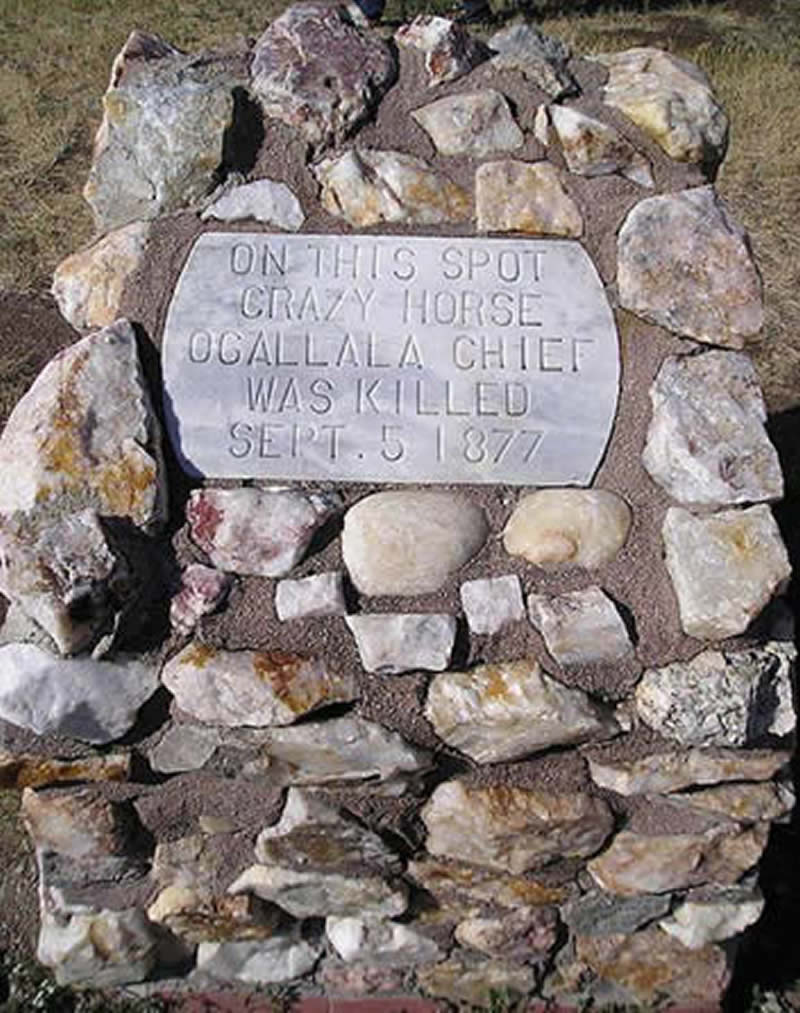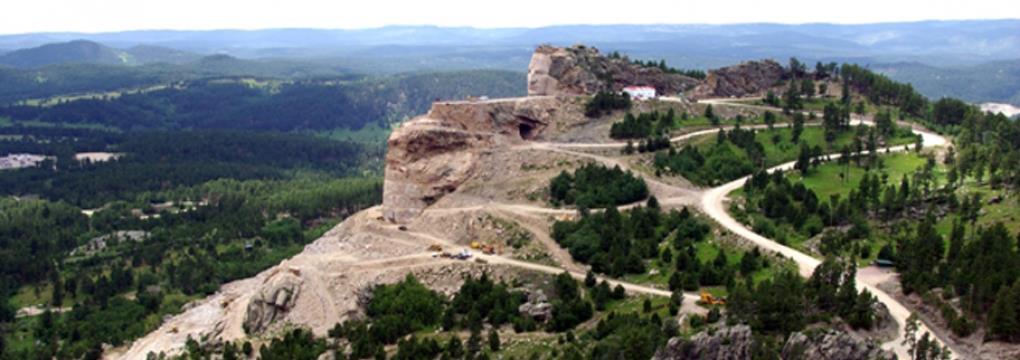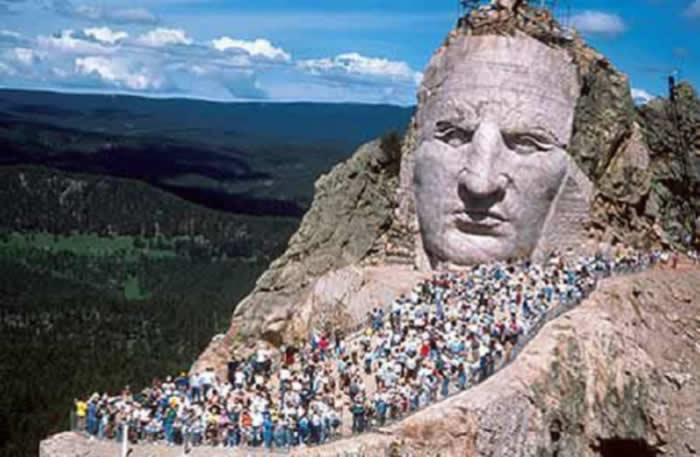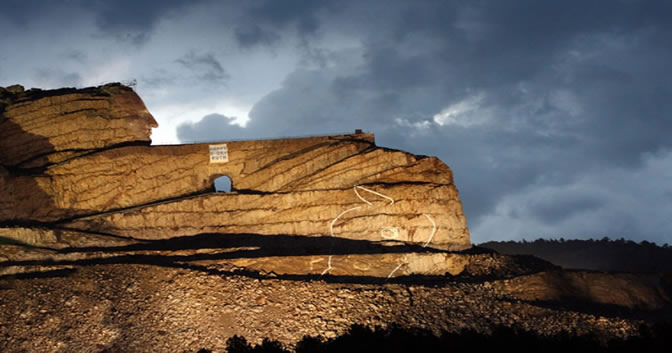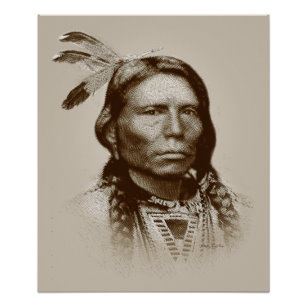
Crazy Horse, born in 1840, was a respected Lakota warrior and leader who fought against the encroachment of white settlers in the Great Plains during the 1860s and 1870s. With his tactical brilliance and bravery on the battlefield, he earned a reputation as one of the greatest Native American warriors of all time. This article will explore the life and times of Crazy Horse, from his early years and spiritual awakening, to his role in the Sioux Wars and the legendary Battle of Little Bighorn. It will also delve into the controversies surrounding his death and the enduring myth and legacy of this iconic figure in American history.
Early Life and Childhood of Crazy Horse
Family Background and Early Years
Crazy Horse was born in 1840 near Rapid Creek in what is now South Dakota. He was given the name "In the Wilderness" at birth. His father, also named Crazy Horse, was a respected warrior and leader of the Lakota Sioux tribe. His mother, Rattling Blanket Woman, was also from a prominent Sioux family.
As a child, Crazy Horse was known for being quiet and introspective. He spent much of his time alone or with his younger sister, who was his close friend and confidante. He was taught to hunt and ride horses at a young age, skills that would serve him well later in life.
The Vision Quest and Spiritual Awakening
When Crazy Horse was a teenager, he went on a vision quest to gain spiritual guidance and find his place in the world. During this time, he had a powerful vision of a warrior riding on a horse, holding a spear. This vision would inspire him for the rest of his life.
After his vision quest, Crazy Horse became deeply spiritual and sought to live a life in accordance with Lakota traditions and values. He became known for his humility, generosity, and dedication to his people.
The First Battle of Crazy Horse
Battles with the Crow Tribe
In the early 1860s, Crazy Horse began his military career as a warrior fighting against the Crow tribe. He quickly gained a reputation for his bravery and skill in battle.
Joining the Oglala Sioux Tribe
Crazy Horse eventually joined the Oglala Sioux tribe and became a leader within his community. He was respected for his wisdom and his dedication to defending his people and their way of life.
Crazy Horse's Role in the Sioux Wars
The Fetterman Massacre and Red Cloud's War
In 1866, Crazy Horse played a key role in the Fetterman Massacre, a battle between the Sioux and the US Army. The battle resulted in the deaths of all 80 soldiers under Captain William J. Fetterman's command. This victory was one of many in the ongoing conflict between the Sioux and the US Army known as Red Cloud's War.
The Battle of Rosebud Creek
In 1876, Crazy Horse led his warriors in the Battle of Rosebud Creek against General George Crook and his army. Although the battle ended in a draw, it was a significant moment in the Sioux Wars and would foreshadow the events of the Battle of Little Bighorn.
Warfare Against General George Armstrong Custer
Later that same year, Crazy Horse played a crucial role in the Battle of Little Bighorn, also known as Custer's Last Stand. Alongside other Sioux leaders, including Sitting Bull and Gall, Crazy Horse defeated Custer and his troops in one of the most famous battles in American history.
The Battle of Little Bighorn and Crazy Horse's Leadership
The Sioux and Cheyenne Alliance
Before the Battle of Little Bighorn, Crazy Horse helped to form a powerful alliance between the Sioux and the Cheyenne tribes. This alliance allowed the tribes to pool their resources and fight together against the common enemy of the US Army.
Crazy Horse's Military Tactics
Crazy Horse was known for his strategic genius and his ability to outmaneuver and outthink his opponents. He favored unconventional tactics, such as attacking from unexpected angles and using decoys to confuse his enemy.
Impact of Victory at Little Bighorn
The Battle of Little Bighorn was a major turning point in the Sioux Wars. It was the last major military victory for the Sioux, and it helped to solidify Crazy Horse's place in history as a legendary warrior and leader. However, it also led to increased aggression from the US Army and ultimately, the defeat of the Sioux and their way of life.
Despite his success in battle, Crazy Horse remained committed to his people and their traditions until his death in a controversial incident in 1877. His legacy lives on as a symbol of resistance and resilience in the face of oppression.
Life on the Reservation and Death of Crazy Horse
Crazy Horse, a prominent Oglala Lakota leader, was born in 1840 in the Black Hills of South Dakota. He was known for his bravery and leadership in battles against the United States government. After years of fighting, Crazy Horse reluctantly surrendered in May 1877, along with his people. They were placed on a reservation in present-day Nebraska, where they struggled to adapt to a new way of life.
Crazy Horse became increasingly disillusioned with life on the reservation and resisted efforts to assimilate the Lakota into white culture. He became involved in a plan to lead his people back to their homeland, known as the Black Hills, where they could live freely and independently. However, his plans were discovered, and he was arrested and killed at Fort Robinson, Nebraska, on September 5, 1877.
Legacy and Historical Significance of Crazy Horse
Crazy Horse became a symbol of resistance against the United States government's encroachment on Native American lands. He represented the struggle of indigenous people to maintain their way of life and their land. His legacy inspired many Native American leaders who came after him, including the American Indian Movement in the 1960s and 1970s.
Crazy Horse is commemorated in many ways, including the Crazy Horse Memorial in South Dakota, which is still under construction. The memorial is a testament to his legacy and serves as a symbol of hope for Native American people.
The Myth and Legend of Crazy Horse
Crazy Horse's life and legacy have become the subject of many oral histories and legends. In Lakota culture, he is seen as a spiritual leader and an embodiment of the Lakota values of courage, generosity, and humility. Many stories depict him as a powerful warrior and a visionary leader who saw the future of his people.
In popular culture, Crazy Horse is often portrayed as a mythical figure, a symbol of Native American resistance and the fight against injustice. He has been depicted in movies, books, and songs, and his legend continues to inspire people around the world.
The Controversies Surrounding Crazy Horse's Death
The circumstances surrounding Crazy Horse's death have been the subject of much controversy. Some believe that he was murdered by soldiers while in custody, while others argue that he was killed in a scuffle with his own people. There are also disputes over the location of his burial site and the whereabouts of his remains.
Despite the controversies, Crazy Horse's legacy and impact on Native American history remain significant. His life and his struggle for the freedom of his people will continue to inspire future generations to fight for justice and equality.Crazy Horse lived a life defined by conflict, courage, and uncompromising devotion to his people and their way of life. Though he died young, his legacy lives on as a symbol of resistance against oppression and a powerful voice for the preservation of Native American culture and traditions. Through his story, we can gain a greater understanding of the struggles and triumphs of the Lakota people and the enduring impact of their fight for freedom and sovereignty.
Frequently Asked Questions (FAQ)
What were Crazy Horse's greatest battles?
Crazy Horse's greatest battles were the Battle of the Rosebud Creek in 1876 and the Battle of the Little Bighorn, also known as Custer's Last Stand, later that same year. He is credited with devising the strategy that led to the Sioux and Cheyenne's victory against Custer's forces.
What was the significance of the Battle of Little Bighorn?
The Battle of Little Bighorn was a seminal moment in the history of the American West, as it represented one of the few victories of Native American forces against the US Army. It was also a turning point in the Great Sioux War, leading to an escalation of violence on both sides.
What is the current status of Crazy Horse's remains?
Crazy Horse's remains are shrouded in controversy and mystery. While some sources suggest that he was buried secretly in an undisclosed location, others claim that his remains were disinterred and later reburied at a location in South Dakota that has become a popular tourist attraction.
What is the significance of Crazy Horse's legacy today?
Crazy Horse's legacy is one of bravery, resistance, and cultural pride. His story continues to inspire Native American activists and leaders in their fight for sovereignty, self-determination, and recognition of their unique cultural heritage. His life and times are also celebrated through various artistic and cultural expressions, including literature, film, and visual arts.
_________________________________
Crazy Horse was born on the Republican River about 1845. He was killed at Fort Robinson, Nebraska, in 1877, so that he lived barely thirty-three years. He was an uncommonly handsome man. While not the equal of Gall in magnificence and imposing stature, he was physically perfect, an Apollo in symmetry. Furthermore he was a true type of Indian refinement and grace. He was modest and courteous as Chief Joseph; the difference is that he was a born warrior, while Joseph was not.
However, he was a gentle warrior, a true brave, who stood for the highest ideal of the Sioux. Notwithstanding all that biased historians have said of him, it is only fair to judge a man by the estimate of his own people rather than that of his enemies. The boyhood of Crazy Horse was passed in the days when the western Sioux saw a white man but seldom, and then it was usually a trader or a soldier. He was carefully brought up according to the tribal customs.
At that period the Sioux prided themselves on the training and development of their sons and daughters, and not a step in that development was overlooked as an excuse to bring the child before the public by giving a feast in its honor. At such times the parents often gave so generously to the needy that they almost impoverished themselves, thus setting an example to the child of self-denial for the general good. His first step alone, the first word spoken, first game killed, the attainment of manhood or womanhood, each was the occasion of a feast and dance in his honor, at which the poor always benefited to the full extent of the parents' ability.
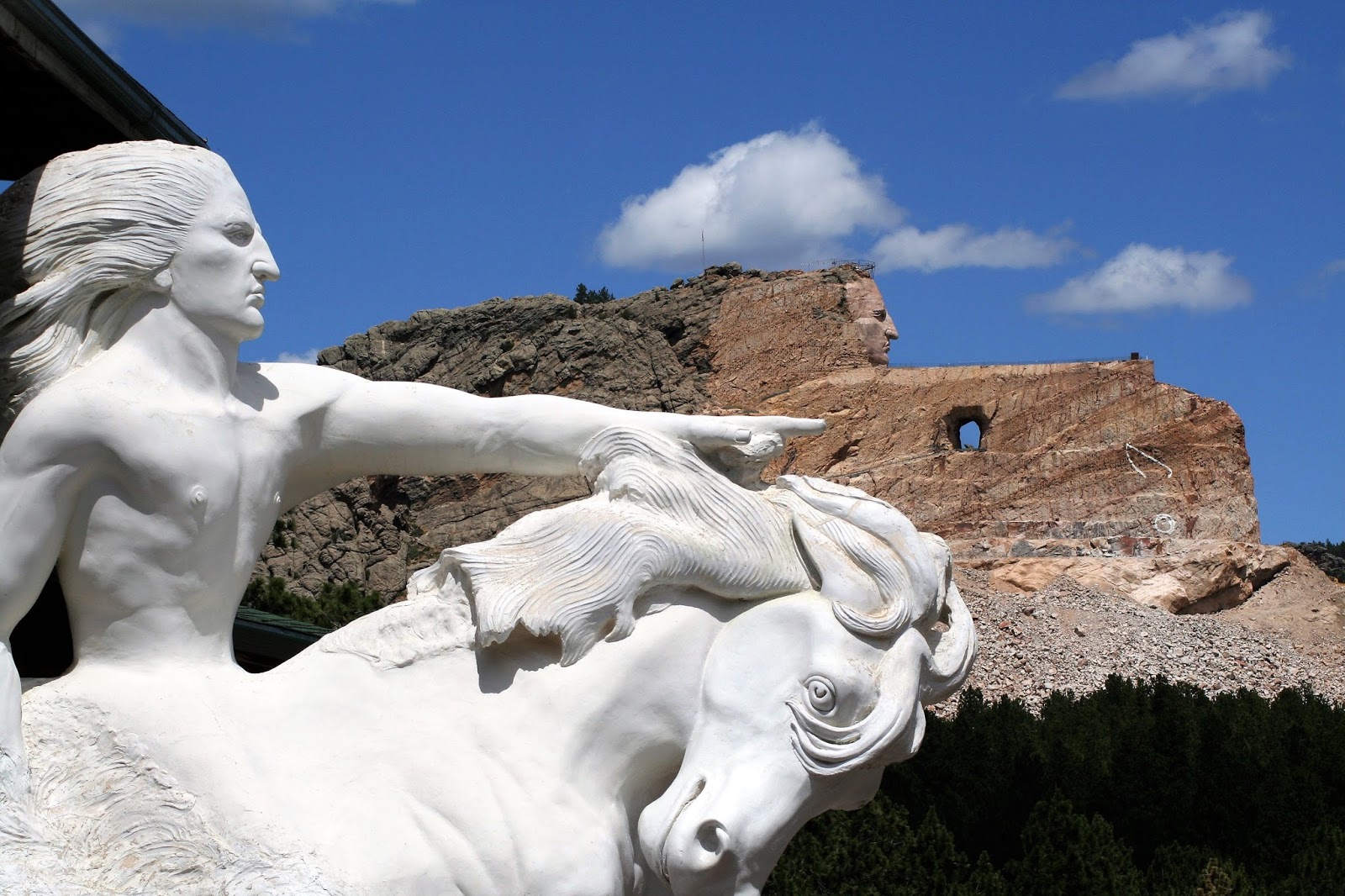
Big-heartedness, generosity, courage, and self-denial are the qualifications of a public servant, and the average Indian was keen to follow this ideal. As every one knows, these characteristic traits become a weakness when he enters a life founded upon commerce and gain. Under such conditions the life of Crazy Horse began. His mother, like other mothers, tender and watchful of her boy, would never once place an obstacle in the way of his father's severe physical training.
They laid the spiritual and patriotic foundations of his education in such a way that he early became conscious of the demands of public service. He was perhaps four or five years old when the band was snowed in one severe winter.
They were very short of food, but his father was a tireless hunter. The buffalo, their main dependence, were not to be found, but he was out in the storm and cold every day and finally brought in two antelopes.
The little boy got on his pet pony and rode through the camp, telling the old folks to come to his mother's teepee for meat. It turned out that neither his father nor mother had authorized him to do this.
Before they knew it, old men and women were lined up before the teepee home, ready to receive the meat, in answer to his invitation. As a result, the mother had to distribute nearly all of it, keeping only enough for two meals. On the following day the child asked for food. His mother told him that the old folks had taken it all, and added: "Remember, my son, they went home singing praises in your name, not my name or your father's. You must be brave. You must live up to your reputation."
Crazy Horse loved horses, and his father gave him a pony of his own when he was very young. He became a fine horseman and accompanied his father on buffalo hunts, holding the pack horses while the men chased the buffalo and thus gradually learning the art. In those days the Sioux had but few guns, and the hunting was mostly done with bow and arrows.
Another story told of his boyhood is that when he was about twelve he went to look for the ponies with his little brother, whom he loved much, and took a great deal of pains to teach what he had already learned. They came to some wild cherry trees full of ripe fruit, and while they were enjoying it, the brothers were startled by the growl and sudden rush of a bear.
Young Crazy Horse pushed his brother up into the nearest tree and himself sprang upon the back of one of the horses, which was frightened and ran some distance before he could control him. As soon as he could, however, he turned him about and came back, yelling and swinging his lariat over his head. The bear at first showed fight but finally turned and ran.
The old man who told me this story added that young as he was, he had some power, so that even a grizzly did not care to tackle him. I believe it is a fact that a silver-tip will dare anything except a bell or a lasso line, so that accidentally the boy had hit upon the very thing which would drive him off. It was usual for Sioux boys of his day to wait in the field after a buffalo hunt until sundown, when the young calves would come out in the open, hungrily seeking their mothers.
Then these wild children would enjoy a mimic hunt, and lasso the calves or drive them into camp. Crazy Horse was found to be a determined little fellow, and it was settled one day among the larger boys that they would "stump" him to ride a good-sized bull calf. He rode the calf, and stayed on its back while it ran bawling over the hills, followed by the other boys on their ponies, until his strange mount stood trembling and exhausted.
At the age of sixteen he joined a war party against the Gros Ventres. He was well in the front of the charge, and at once established his bravery by following closely one of the foremost Sioux warriors, by the name of Hump, drawing the enemy's fire and circling around their advance guard. Suddenly Hump's horse was shot from under him, and there was a rush of warriors to kill or capture him while down.
But amidst a shower of arrows the youth leaped from his pony, helped his friend into his own saddle, sprang up behind him, and carried him off in safety, although they were hotly pursued by the enemy. Thus he associated himself in his maiden battle with the wizard of Indian warfare, and Hump, who was then at the height of his own career, pronounced Crazy Horse the coming warrior of the Teton Sioux.
At this period of his life, as was customary with the best young men, he spent much time in prayer and solitude. Just what happened in these days of his fasting in the wilderness and upon the crown of bald buttes, no one will ever know; for these things may only be known when one has lived through the battles of life to an honored old age.
He was much sought after by his youthful associates, but was noticeably reserved and modest; yet in the moment of danger he at once rose above them all -- a natural leader! Crazy Horse was a typical Sioux brave, and from the point of view of our race an ideal hero, living at the height of the epical progress of the American Indian and maintaining in his own character all that was most subtle and ennobling of their spiritual life, and that has since been lost in the contact with a material civilization.
He loved Hump, that peerless warrior, and the two became close friends, in spite of the difference in age. Men called them "the grizzly and his cub." Again and again the pair saved the day for the Sioux in a skirmish with some neighboring tribe. But one day they undertook a losing battle against the Snakes. The Sioux were in full retreat and were fast being overwhelmed by superior numbers. The old warrior fell in a last desperate charge; but Crazy Horse and his younger brother, though dismounted, killed two of the enemy and thus made good their retreat.
It was observed of him that when he pursued the enemy into their stronghold, as he was wont to do, he often refrained from killing, and simply struck them with a switch, showing that he did not fear their weapons nor care to waste his upon them. In attempting this very feat, he lost this only brother of his, who emulated him closely.
A party of young warriors, led by Crazy Horse, had dashed upon a frontier post, killed one of the sentinels, stampeded the horses, and pursued the herder to the very gate of the stockade, thus drawing upon themselves the fire of the garrison. The leader escaped without a scratch, but his young brother was brought down from his horse and killed.
While he was still under twenty, there was a great winter buffalo hunt, and he came back with ten buffaloes' tongues which he sent to the council lodge for the councilors' feast.
He had in one winter day killed ten buffalo cows with his bow and arrows, and the unsuccessful hunters or those who had no swift ponies were made happy by his generosity. When the hunters returned, these came chanting songs of thanks.
He knew that his father was an expert hunter and had a good horse, so he took no meat home, putting in practice the spirit of his early teaching.
He attained his majority at the crisis of the difficulties between the United States and the Sioux. Even before that time, Crazy Horse had already proved his worth to his people in Indian warfare. He had risked his life again and again, and in some instances it was considered almost a miracle that he had saved others as well as himself. He was no orator nor was he the son of a chief. His success and influence was purely a matter of personality.
He had never fought the whites up to this time, and indeed no "coup" was counted for killing or scalping a white man. Young Crazy Horse was twenty-one years old when all the Teton Sioux chiefs (the western or plains dwellers) met in council to determine upon their future policy toward the invader. Their former agreements had been by individual bands, each for itself, and every one was friendly. They reasoned that the country was wide, and that the white traders should be made welcome.
Up to this time they had anticipated no conflict. They had permitted the Oregon Trail, but now to their astonishment forts were built and garrisoned in their territory. Most of the chiefs advocated a strong resistance. There were a few influential men who desired still to live in peace, and who were willing to make another treaty. Among these were White Bull, Two Kettle, Four Bears, and Swift Bear. Even Spotted Tail, afterward the great peace chief, was at this time with the majority, who decided in the year 1866 to defend their rights and territory by force. Attacks were to be made upon the forts within their country and on every trespasser on the same.
Crazy Horse took no part in the discussion, but he and all the young warriors were in accord with the decision of the council. Although so young, he was already a leader among them. Other prominent young braves were Sword (brother of the man of that name who was long captain of police at Pine Ridge), the younger Hump, Charging Bear, Spotted Elk, Crow King, No Water, Big Road, He Dog, the nephew of Red Cloud, and Touch-the-Cloud, intimate friend of
Crazy Horse. The attack on Fort Phil Kearny was the first fruits of the new policy, and here Crazy Horse was chosen to lead the attack on the woodchoppers, designed to draw the soldiers out of the fort, while an army of six hundred lay in wait for them.
The success of this stratagem was further enhanced by his masterful handling of his men. From this time on a general war was inaugurated; Sitting Bull looked to him as a principal war leader, and even the Cheyenne chiefs, allies of the Sioux, practically acknowledged his leadership.
Yet during the following ten years of defensive war he was never known to make a speech, though his teepee was the rendezvous of the young men. He was depended upon to put into action the decisions of the council, and was frequently consulted by the older chiefs. Like Osceola, he rose suddenly; like Tecumseh he was always impatient for battle; like Pontiac, he fought on while his allies were suing for peace, and like Grant, the silent soldier, he was a man of deeds and not of words. He won from Custer and Fetterman and Crook.
He won every battle that he undertook, with the exception of one or two occasions when he was surprised in the midst of his women and children, and even then he managed to extricate himself in safety from a difficult position.
Early in the year 1876, his runners brought word from Sitting Bull that all the roving bands would converge upon the upper Tongue River in Montana for summer feasts and conferences.
There was conflicting news from the reservation. It was rumored that the army would fight the Sioux to a finish; again, it was said that another commission would be sent out to treat with them. The Indians came together early in June, and formed a series of encampments stretching out from three to four miles, each band keeping separate camp. On June 17, scouts came in and reported the advance of a large body of troops under General Crook. The council sent Crazy Horse with seven hundred men to meet and attack him.
These were nearly all young men, many of them under twenty, the flower of the hostile Sioux. They set out at night so as to steal a march upon the enemy, but within three or four miles of his camp they came unexpectedly upon some of his Crow scouts. There was a hurried exchange of shots; the Crows fled back to Crook's camp, pursued by the Sioux. The soldiers had their warning, and it was impossible to enter the well-protected camp. Again and again Crazy Horse charged with his bravest men, in the attempt to bring the troops into the open, but he succeeded only in drawing their fire.
Toward afternoon he withdrew, and returned to camp disappointed. His scouts remained to watch Crook's movements, and later brought word that he had retreated to Goose Creek and seemed to have no further disposition to disturb the Sioux. It is well known to us that it is Crook rather than Reno who is to be blamed for cowardice in connection with Custer's fate. The latter had no chance to do anything, he was lucky to save himself; but if Crook had kept on his way, as ordered, to meet Terry, with his one thousand regulars and two hundred Crow and Shoshone scouts, he would inevitably have intercepted
Custer in his advance and saved the day for him, and war with the Sioux would have ended right there. Instead of this, he fell back upon Fort Meade, eating his horses on the way, in a country swarming with game, for fear of Crazy Horse and his braves! The Indians now crossed the divide between the Tongue and the Little Big Horn, where they felt safe from immediate pursuit.
Here, with all their precautions, they were caught unawares by General Custer, in the midst of their midday games and festivities, while many were out upon the daily hunt. On this twenty-fifth of June, 1876, the great camp was scattered for three miles or more along the level river bottom, back of the thin line of cottonwoods -- five circular rows of teepees, ranging from half a mile to a mile and a half in circumference. Here and there stood out a large, white, solitary teepee; these were the lodges or "clubs" of the young men.
Crazy Horse was a member of the "Strong Hearts" and the "Tokala" or Fox lodge. He was watching a game of ring-toss when the warning came from the southern end of the camp of the approach of troops. The Sioux and the
Cheyennes were "minute men", and although taken by surprise, they instantly responded. Meanwhile, the women and children were thrown into confusion.
Dogs were howling, ponies running hither and thither, pursued by their owners, while many of the old men were singing their lodge songs to encourage the warriors, or praising the "strong heart" of Crazy Horse.
That leader had quickly saddled his favorite war pony and was starting with his young men for the south end of the camp, when a fresh alarm came from the opposite direction, and looking up, he saw Custer's force upon the top of the bluff directly across the river. As quick as a flash, he took in the situation -- the enemy had planned to attack the camp at both ends at once; and knowing that Custer could not ford the river at that point, he instantly led his men northward to the ford to cut him off. The Cheyennes followed closely.
Custer must have seen that wonderful dash up the sage-bush plain, and one wonders whether he realized its meaning. In a very few minutes, this wild general of the plains had outwitted one of the most brilliant leaders of the Civil War and ended at once his military career and his life. In this dashing charge,
Crazy Horse snatched his most famous victory out of what seemed frightful peril, for the Sioux could not know how many were behind Custer. He was caught in his own trap. To the soldiers it must have seemed as if the Indians rose up from the earth to overwhelm them.
They closed in from three sides and fought until not a white man was left alive.
Then they went down to Reno's stand and found him so well intrenched in a deep gully that it was impossible to dislodge him. Gall and his men held him there until the approach of General Terry compelled the Sioux to break camp and scatter in different directions.
While Sitting Bull was pursued into Canada, Crazy Horse and the Cheyennes wandered about, comparatively undisturbed, during the rest of that year, until in the winter the army surprised the Cheyennes, but did not do them much harm, possibly because they knew that Crazy Horse was not far off. His name was held in wholesome respect.
From time to time, delegations of friendly Indians were sent to him, to urge him to come in to the reservation, promising a full hearing and fair treatment. For some time he held out, but the rapid disappearance of the buffalo, their only means of support, probably weighed with him more than any other influence. In July, 1877, he was finally prevailed upon to come in to Fort Robinson, Nebraska, with several thousand Indians, most of them Ogallala and Minneconwoju Sioux, on the distinct understanding that the government would hear and adjust their grievances.
At this juncture General Crook proclaimed Spotted Tail, who had rendered much valuable service to the army, head chief of the Sioux, which was resented by many. The attention paid Crazy Horse was offensive to Spotted Tail and the Indian scouts, who planned a conspiracy against him. They reported to General
Crook that the young chief would murder him at the next council, and stampede the Sioux into another war.
He was urged not to attend the council and did not, but sent another officer to represent him. Meanwhile the friends of Crazy Horse discovered the plot and told him of it. His reply was, "Only cowards are murderers." His wife was critically ill at the time, and he decided to take her to her parents at Spotted Tail agency, whereupon his enemies circulated the story that he had fled, and a party of scouts was sent after him.
They overtook him riding with his wife and one other but did not undertake to arrest him, and after he had left the sick woman with her people he went to call on Captain Lea, the agent for the Brules, accompanied by all the warriors of the Minneconwoju band. This volunteer escort made an imposing appearance on horseback, shouting and singing, and in the words of Captain Lea himself and the missionary, the Reverend Mr. Cleveland, the situation was extremely critical.
Indeed, the scouts who had followed Crazy Horse from Red Cloud agency were advised not to show themselves, as some of the warriors had urged that they be taken out and horsewhipped publicly.
Under these circumstances Crazy Horse again showed his masterful spirit by holding these young men in check. He said to them in his quiet way: "It is well to be brave in the field of battle; it is cowardly to display bravery against one's own tribesmen. These scouts have been compelled to do what they did; they are no better than servants of the white officers. I came here on a peaceful errand." The captain urged him to report at army headquarters to explain himself and correct false rumors, and on his giving consent, furnished him with a wagon and escort.
It has been said that he went back under arrest, but this is untrue. Indians have boasted that they had a hand in bringing him in, but their stories are without foundation. He went of his own accord, either suspecting no treachery or determined to defy it.
When he reached the military camp, Little Big Man walked arm-in-arm with him, and his cousin and friend, Touch-the-Cloud, was just in advance. After they passed the sentinel, an officer approached them and walked on his other side.
He was unarmed but for the knife which is carried for ordinary uses by women as well as men.
Unsuspectingly he walked toward the guardhouse, when Touch-the-Cloud suddenly turned back exclaiming: "Cousin, they will put you in prison!" "Another white man's trick! Let me go! Let me die fighting!" cried Crazy Horse. He stopped and tried to free himself and draw his knife, but both arms were held fast by Little Big Man and the officer. While he struggled thus, a soldier thrust him through with his bayonet from behind.
The wound was mortal, and he died in the course of that night, his old father singing the death song over him and afterward carrying away the body, which they said must not be further polluted by the touch of a white man. They hid it somewhere in the Bad Lands, his resting place to this day. Thus died one of the ablest and truest American Indians.
His life was ideal; his record clean. He was never involved in any of the numerous massacres on the trail, but was a leader in practically every open fight. Such characters as those of Crazy Horse and Chief Joseph are not easily found among so-called civilized people.
The reputation of great men is apt to be shadowed by questionable motives and policies, but here are two pure patriots, as worthy of honor as any who ever breathed God's air in the wide spaces of a new world.
written by Charles Eastmen, 1913
After surrendering to U.S. troops under General Crook in 1877, Crazy Horse was fatally wounded by a military guard while allegedly resisting imprisonment at Camp Robinson in present-day Nebraska. He ranks among the most notable and iconic of Native American tribal members and has been honored by the U.S. Postal Service with a 13¢ Great Americans series postage stamp.
Tribe Oglala Lakota
Born ca. 1840
Died September 5, 1877
Fort Robinson
Native name Tȟašúŋke Witkó; birth name, Cha-O-Ha ("In the Wilderness" or "Among the Trees")
Crazy Horse (Lakota: Tȟašúŋke Witkó in Standard Lakota Orthography, IPA:tχaʃʊ̃kɛ witkɔ), literally "His-Horse-Is-Crazy" or "His-Horse-Is-Spirited"; ca. 1840 – September 5, 1877) was a Native American war leader of the Oglala Lakota. He took up arms against the U.S. Federal government to fight against encroachments on the territories and way of life of the Lakota people, including leading a war party to victory at the Battle of the Little Bighorn in June 1876.
http://en.wikipedia.org/wiki/Crazy_Horse
